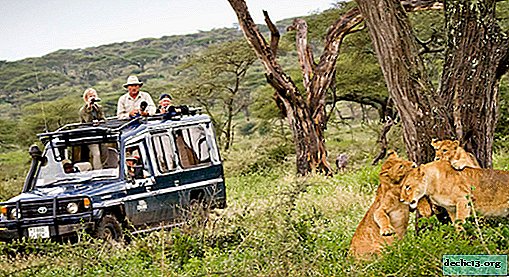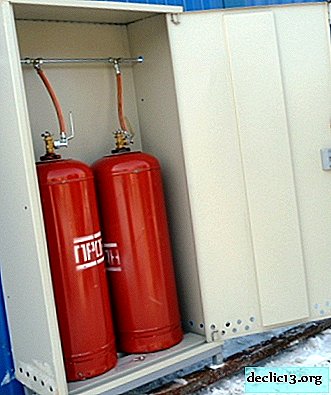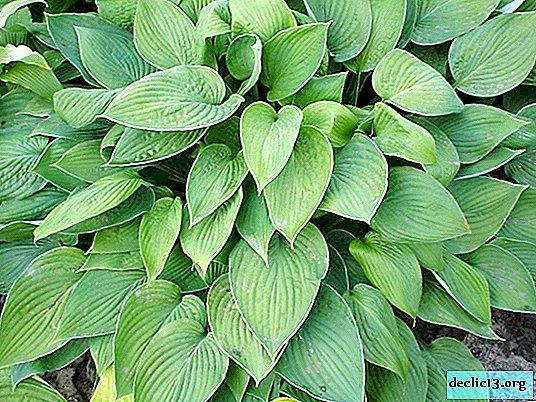Tanzania Safari - Which National Park to Visit
In Tanzania, there are almost no other attractions besides national parks and other protected ecoterritories. Hot air ballooning over the expanses of savannahs, ecological tours, exciting safaris - in Tanzania, national parks are an ideal place for a variety of entertainment.

Tanzania is rightly recognized as one of the most interesting countries on the planet in environmental terms, it is also known as one of the best places on Earth for eco-tourism. Almost a third of its entire territory is a protected area, which includes 15 national parks (total area of more than 42,000 km²), marine parks, 13 wildlife sanctuaries, a nature reserve and other nature conservation zones.
For travelers from the CIS countries planning to go on an eco-trip through the national parks of Tanzania, a map in Russian has been compiled. And in order to successfully choose a specific place for a safari in this country, you first need to understand many of the nuances. So, a little detailed information about the most significant conservation areas of Tanzania, as well as the cost of safari and the opportunity to save.
Safari in Tanzania: all the nuances of the financial side of the issue

You can buy a tour in advance via the Internet - just enter the phrase "safari in Tanzania" in the Googl search engine, or you can buy it on the spot - in Tanzania there are a lot of companies offering their services for organizing a safari.
As for the financial side of the issue, the budget safari in this state will cost at least $ 300. What does this figure consist of? By themselves, tickets to any ecozone are not so expensive - from $ 40 to $ 60. But the fact is that you cannot ride a safari in Tanzania alone in any park, only with a guide and a car! Moreover, the guide must be a Tanzanian with the appropriate certificate, and the car - only a safari jeep, having the formula 4WD and equipped with a panoramic roof. And for the guide and the car you have to pay. Fortunately, there are options to save.

- There are several groups on Facebook where tourists from different countries are looking for travel companions for their safari. They do this for the sole purpose of sharing the costs of a guide, a car and gasoline for all fellow travelers (there can be 5 or 6 passengers in a safari jeep). As a result, the cost of a safari in Tanzania may decrease by 2-3 times. The main problem will be the search for fellow travelers, because it is quite problematic to organize completely strangers in a foreign country. But since this method has existed for several years and has been tested by time, it means that it works.
- This option is suitable for backpackers who have free time, are fluent in English and can work on platforms like WordPress. Many tour guides and companies need websites, and in Tanzania only a few people are able to develop them, and they require incredibly large amounts for this. You can try to negotiate with a tour company or with a guide with a car: developing a website in exchange for a trip to the national park for a couple of days. By the way, it’s better to negotiate a safari in Serengeti Park, as this is the most expensive option. This is an effective way, since the cost of creating a page on the Internet is much higher than the cost of a safari for one person, and Tanzanians benefit from such an exchange.

Serengeti National Park
The largest, most expensive, famous and most visited Tanzania National Park is the Serengeti. The Serengeti Valley is called the "boundless African Plain" for its vast territory of 14,763 km².

Serengeti has one interesting feature: every year there is a massive migration of ungulates. When the drought season begins in the north of the park (October-November), more than 1,000,000 wildebeests and about 220,000 zebras go to the plains on the south side, where it rains for a short time. When it begins to rain in the north and west (April-June), herds of animals return.

During the Serengeti safari, you can meet all the representatives of the "Big African Five": lions, leopards, elephants, buffalos, and rhinos. Here you can also see giraffes, cheetahs, hyenas, jackals, wolves, ostriches.
How much is a safari in Serengeti
300 km from the regional city of Arusha to Serengeti, and most of this is off-road - accordingly, it will take a lot of time to travel there, and also the road back. This is the main reason why the guides do not agree to go to the park for 1, or even 2 days. The smallest term for which you need to hire a car and guide from local tour operators at the prices set for a safari in Tanzania is 3 days. At best, $ 80 can be enough for gasoline, but it will probably take $ 100.
It is also necessary to add the cost of food and housing.
 Ngorongoro
NgorongoroThere are still very interesting points. Firstly, $ 60 is the price for entering the park for only one day, you will have to pay again for each subsequent day! Secondly, the road to Serengeti Park passes through the Ngorongoro Conservation Area, the entrance to which costs $ 200 per car and $ 50 per person. And on the way back again you will have to pay the same amount, it doesn’t matter which way to enter the reserve, anyway the road will pass through its territory. The result is a very impressive amount, about $ 1,500.
Fortunately, there are options for saving while traveling through the parks of Tanzania, as mentioned above.
AccommodationThere are a large number of lodges in the park - luxury hotels, where a chic room costs from $ 300 per day. Cheaper accommodation will be at private campsites, where prices start from $ 150. Usually these are huge tents with all amenities. It’s more convenient to search for such options on Booking, and you need to book accommodation in advance.
 Simba campsite
Simba campsiteThe cheapest will be overnight in a public campsite, arranged among the expanses of the national park - the most popular among tourists were Simba Campsite and Seronera Public Campsite. There are toilets and showers with cold water on the campsite, but there is no electricity, so you need to have alternative lighting devices with you. One night's place with your own tent will cost $ 30, but since there are no fences around the campsites, wild animals often go near the tents. And this means that putting your tent is not entirely safe. It’s better to pay another $ 50 and rent a safari jeep with a roof tent in the travel company. When it is dark, it is not advisable to go out, and it is unlikely that you want to: the whole space is filled with the voices of wild animals, and predatory animals go on a night hunt.
Ngorongoro Conservation Area
The most convenient way to explore Ngorongoro on the way to the Serengeti National Park.

The conservation of Ngorongoro spreads over 8 288 km² around the eponymous crater of an extinct volcano, standing on the edge of the Serengeti savannah. This area has meadows, lakes, swamps, forests and even wasteland - and all this is a heritage of UNESCO.
This large-scale tropical eco-zone is characterized by its own special, unique wildlife, and therefore the safari here is always very interesting. In Ngorongoro, 1 km² accounts for the largest number of animal species in Tanzania. In the forests you can meet herds of peacefully grazing elephants, on the plains you can see leisurely buffalos and frolic zebras, and admire hippos near the water. And in this reserve there are black rhinos, wildebeests, lions, leopards, hyenas, ostriches.

To reach the bottom of the caldera, where you can watch different animals, you need to drive along the crest of the crater for about 25 km. Since the peak of Ngorongoro is 2,235 m above sea level, it is always much colder there than at the bottom of the caldera, where it is quite hot.
For a safari in the reserve of Tanzania, you need to pay $ 200 for the entry of the car and $ 50 for each person in it. If the safari takes longer than 6 hours, then when you leave the reserve park you will have to pay extra for another day of safari.
Lake Manyara National Park
On the way to Serengeti Park and Ngorongoro Crater, there is another ecological territory of Tanzania. This is Lake Manyara, one of the smallest national parks in the country, covering an area of 644 km². Arusha can be reached there in just 1.5 hours (distance 126 km), and from Kilimanjaro Airport in 2 hours. Almost right in front of the park, the road passes through the village of Mto-Wa-Mbu, which has a good market with fresh inexpensive fruits and shops with a good selection of antiques.

On the eastern horizon of this unique conservation zone, the 600-meter brownish-red steep walls of the East African Rift Valley are visible, and in its southern part numerous hot springs go to the surface of the earth. Most of the park’s territory is almost always drowning in the haze, which creates the stunningly beautiful soda lake Manyara.
More than 400 species of birds live around the lake, some of them endemic. The park has many cranes, storks, pink pelicans, cormorants, vultures, African beaks, ibises, eagles are not uncommon here.

And from June to September, entire colonies of pink flamingos settle here, migrating throughout the year from one reservoir to another. A huge population of these birds is located where crustaceans are found in abundance. It is thanks to this diet, or rather, the carotene pigment contained in it, that flamingos are pink in color. The chicks hatch grayish-white, and only after a year does their plumage turn pink.
A Lake Manyara safari gives you the opportunity to watch elephants, buffalos, black rhinos, giraffes, zebras, hippos, wildebeests, lions, leopards.

When is it better to go on a safari to Tanzania, to Lake Manyara Park? If the purpose of the trip is to see the animals in their habitat, then it is worth going there in the dry season, that is, from July to October. To watch the birds, admire the waterfalls or go canoeing, the rainy season is best. In November and December, it rains for a short time, humidity and air temperature increase significantly. March-June is a period of prolonged rains.
Tarangire National Park
Literally 7 km from Lake Manyara and 118 km from the city of Arusha, there is another conservation area of Tanzania - Tarangire Park with an area of 2,850 km². The park is located in the hilly steppe of Masai, and got its name in honor of the eponymous river, which supplies water to the entire nearby territory.

A huge number of long-lived baobabs grow in Tarangir, and thanks to these plants, the park is inhabited by the largest elephant population in Tanzania. Going around wild spaces, you can meet zebras, giraffes, antelopes, and as for predators, it is much more difficult to see them.
Tarangire will be interesting for ornithologists. Here you can find endemic masked lovebirds, a group of rhinoceros birds. Noteworthy is the African Great Bustard, which is the world's largest flying bird (males weigh up to 20 kg).

It is better to go on a safari to this ecozone of Tanzania in the dry season, when thousands of animals gather near the Tarangire River. Dry months are January, February and June-October. You can come here in November and December, when there is short rain. The most inappropriate time for a safari in this park is April-May, when there is a lot of rainfall, and most of the camps are closed.

Tarangire is one of the cheapest safari parks in Tanzania - the price of an admission ticket is $ 53. Car rental and guide services will cost about $ 300. There will be enough day for a full safari, especially since you have to pay for every day you are in the park. For those travelers who still decide to stay here for the night, lodge rooms are available at prices starting from $ 150 per day. You need to book rooms in advance, best on Booking.
Kilimanjaro National Park
The list of national parks in Tanzania includes Kilimanjaro. It is located in the north of the state, 130 km from Arusha.

There are heather fields, mountain forests and deserts on an area of 1,668 km². But the main attraction of this area is Mount Kilimanjaro (5,890 m). Here it is called the "crown of Tanzania", and it is unique in many respects:
- the highest solitary mountain on the planet;
- highest peak in Africa;
- the highest peak on Earth, which is possible to climb without special climbing equipment.
- sleeping volcano.

Every year, about 15,000 people try to conquer Kilimanjaro, but only 40% succeed. Climbing to the top and descent from there in time takes from 4 to 7 days. Climbing to the top costs from $ 1,000, for level II the cost of climbing is $ 700, for I - $ 300.
Although climbing Kilimanjaro is allowed throughout the year, the best time is considered to be from August to October and from January to March. At other times, the peak is often buried in clouds, and you won’t be able to admire its snow cap.

Not everyone decides on such an extreme entertainment, some tourists book a helicopter sightseeing tour with travel companies. For a flight alone you will have to pay about $ 600, if there are four passengers, the cost will decrease to about $ 275.
By the way, it is absolutely not necessary to spend such amounts, because the bottom of Mount Kilimanjaro looks no less, and some believe that it is even more attractive.
Traveling through the Kilimanjaro National Park, you can see many animals of Africa. Among its inhabitants there are elephants, leopards, buffalos, monkeys.
More information about Kilimanjaro volcano and how to climb it is presented in this article.Find out RATES or book any accommodation using this form
Mikumi National Park
Mikumi is the fourth largest park in Tanzania in size - it is located on the banks of the Ruaha River, occupying 3,230 km².

Mikumi is famous for the fact that many animals migrate along it: zebras, buffalos, impals. Its expanses are inhabited by elephants, baboons, serval, monkeys, giraffes, and there are hippos - they can be seen at the lakes, which are located 5 km north of the main entrance. And spacious meadows are a favorite area of the world's largest cannon antelopes and black antelopes. Such an “assortment of food” cannot but attract predators: lions often settle on tree branches and on top of termite mounds.

Many travelers consider Mikumi Park the best place for a safari in Tanzania. Thanks to the roads passing through its territory, it is possible to observe animals in any corner of the park. It is also important that the safari here is cheaper than in the north of Tanzania. Of course, you have to hire a jeep with a guide, but even in half a day you can see almost all the inhabitants here.
All prices on the page are for September 2018.
Compare accommodation prices using this form
Conclusion
Of course, a safari in Tanzania is not a cheap treat. But the ancient pristine land, unbelievably beautiful nature and the world of wild animals cost such money.

















